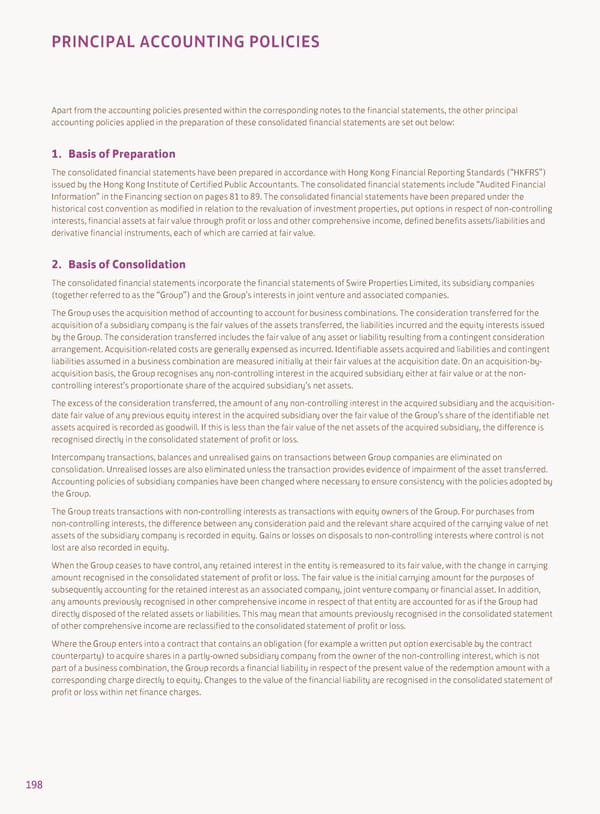PRINCIPAL ACCOUNTING POLICIES Apart from the accounting policies presented within the corresponding notes to the financial statements, the other principal accounting policies applied in the preparation of these consolidated financial statements are set out below: 1. Basis of Preparation The consolidated financial statements have been prepared in accordance with Hong Kong Financial Reporting Standards (“HKFRS”) issued by the Hong Kong Institute of Certified Public Accountants. The consolidated financial statements include “Audited Financial Information” in the Financing section on pages 81 to 89. The consolidated financial statements have been prepared under the historical cost convention as modified in relation to the revaluation of investment properties, put options in respect of non-controlling interests, financial assets at fair value through profit or loss and other comprehensive income, defined benefits assets/liabilities and derivative financial instruments, each of which are carried at fair value. 2. Basis of Consolidation The consolidated financial statements incorporate the financial statements of Swire Properties Limited, its subsidiary companies (together referred to as the “Group”) and the Group’s interests in joint venture and associated companies. The Group uses the acquisition method of accounting to account for business combinations. The consideration transferred for the acquisition of a subsidiary company is the fair values of the assets transferred, the liabilities incurred and the equity interests issued by the Group. The consideration transferred includes the fair value of any asset or liability resulting from a contingent consideration arrangement. Acquisition-related costs are generally expensed as incurred. Identifiable assets acquired and liabilities and contingent liabilities assumed in a business combination are measured initially at their fair values at the acquisition date. On an acquisition-by- acquisition basis, the Group recognises any non-controlling interest in the acquired subsidiary either at fair value or at the non- controlling interest’s proportionate share of the acquired subsidiary’s net assets. The excess of the consideration transferred, the amount of any non-controlling interest in the acquired subsidiary and the acquisition- date fair value of any previous equity interest in the acquired subsidiary over the fair value of the Group’s share of the identifiable net assets acquired is recorded as goodwill. If this is less than the fair value of the net assets of the acquired subsidiary, the difference is recognised directly in the consolidated statement of profit or loss. Intercompany transactions, balances and unrealised gains on transactions between Group companies are eliminated on consolidation. Unrealised losses are also eliminated unless the transaction provides evidence of impairment of the asset transferred. Accounting policies of subsidiary companies have been changed where necessary to ensure consistency with the policies adopted by the Group. The Group treats transactions with non-controlling interests as transactions with equity owners of the Group. For purchases from non-controlling interests, the difference between any consideration paid and the relevant share acquired of the carrying value of net assets of the subsidiary company is recorded in equity. Gains or losses on disposals to non-controlling interests where control is not lost are also recorded in equity. When the Group ceases to have control, any retained interest in the entity is remeasured to its fair value, with the change in carrying amount recognised in the consolidated statement of profit or loss. The fair value is the initial carrying amount for the purposes of subsequently accounting for the retained interest as an associated company, joint venture company or financial asset. In addition, any amounts previously recognised in other comprehensive income in respect of that entity are accounted for as if the Group had directly disposed of the related assets or liabilities. This may mean that amounts previously recognised in the consolidated statement of other comprehensive income are reclassified to the consolidated statement of profit or loss. Where the Group enters into a contract that contains an obligation (for example a written put option exercisable by the contract counterparty) to acquire shares in a partly-owned subsidiary company from the owner of the non-controlling interest, which is not part of a business combination, the Group records a financial liability in respect of the present value of the redemption amount with a corresponding charge directly to equity. Changes to the value of the financial liability are recognised in the consolidated statement of profit or loss within net finance charges. 198
 2022 Annual Report Page 199 Page 201
2022 Annual Report Page 199 Page 201